Day21-自定义分页
一. 先简单来个示例
1.1 在urls.py中增加1条,user_list
from django.conf.urls import url,include
from django.contrib import admin
from app01 import views
urlpatterns = [
url(r'^tpl_1/', views.tpl_1),
url(r'^tpl_2/', views.tpl_2),
url(r'^tpl_3/', views.tpl_3),
url(r'^tpl_4/', views.tpl_4),
url(r'^user_list/', views.user_list),
]
1.2 在views.py中写user_list函数 (后端)
LIST=[]
for i in range(100):
LIST.append(i)
def user_list(request):
current_page=request.GET.get('p')
current_page=int(current_page)
start=(current_page-1)*10
end=current_page*10
data=LIST[start:end]
return render(request,'user_list.html',{'li':data})
1.3 写user_list.html模板 (前端)
<!DOCTYPE html>
<html lang="en">
<head>
<meta charset="UTF-8">
<title>Title</title>
</head>
<body>
<ul>
{% for item in li %}
{% include 'li.html' %}
{%endfor%}
</ul>
<div>
<a href="/user_list/?p=1">1</a>
<a href="/user_list/?p=2">2</a>
<a href="/user_list/?p=3">3</a>
</div>
</body>
</html>
1.4 写li.html

1.5 效果

二,上述的缺点:不知道该写多少个a标签,尝试把分页信息写到后端然后传给前端
views.py
LIST=[]
for i in range(100):
LIST.append(i)
page_str='''
<a href="/user_list/?p=1">1</a>
<a href="/user_list/?p=2">2</a>
<a href="/user_list/?p=3">3</a>
'''
def user_list(request):
current_page=request.GET.get('p')
current_page=int(current_page)
start=(current_page-1)*10
end=current_page*10
data=LIST[start:end]
return render(request,'user_list.html',{'li':data,'page_str':page_str})
user_list.html修改如下:
<!DOCTYPE html>
<html lang="en">
<head>
<meta charset="UTF-8">
<title>Title</title>
</head>
<body>
<ul>
{% for item in li %}
{% include 'li.html' %}
{%endfor%}
</ul>
<div>
{{page_str}}
</div>
</body>
</html>
效果:
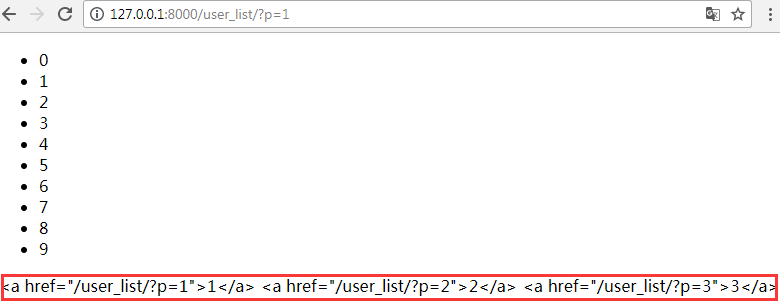
这是出于安全的考虑,所有传来的字符串都认为是不安全的。如果想让其正常显示,需要加入safe,如下:
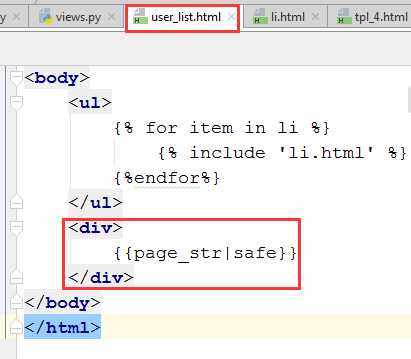
现在就可以正常显示了

三,另外一种方法:把字符串在后台包装一下,声明它是安全的。
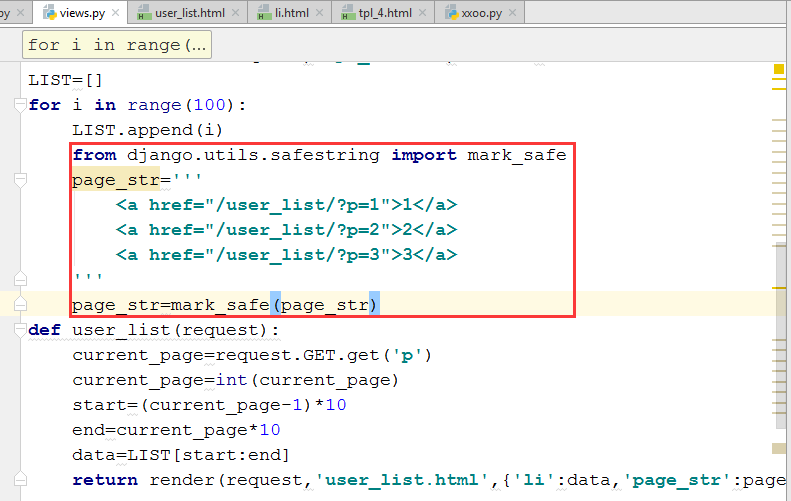
四,根据内容的多少,自动实现分页
最终效果:

粘贴核心程序如下及部分说明:
count,y=divmod(all_count,10)-------取商和余数
page_str="".join(page_list)------以空格相连
page_str=mark_safe(page_str) ----------声明它们是安全的
urls.py
urlpatterns = [
url(r'^tpl_1/', views.tpl_1),
url(r'^tpl_2/', views.tpl_2),
url(r'^tpl_3/', views.tpl_3),
url(r'^tpl_4/', views.tpl_4),
url(r'^user_list/', views.user_list),
]
views.py
from django.shortcuts import render,HttpResponse
from django.urls import reverse
# Create your views here.
def tpl_1(request):
user_list=[1,2,3,4]
return render(request,'tpl_1.html',{'u':user_list})
def tpl_2(request):
name='root'
return render(request,'tpl_2.html',{'name':name})
def tpl_3(request):
status='已删除'
return render(request,'tpl_3.html',{'status':status})
def tpl_4(request):
name='AAABBBIYMFD12345'
return render(request,'tpl_4.html',{'name':name})
from django.utils.safestring import mark_safe
LIST=[]
for i in range(100):
LIST.append(i)
def user_list(request):
current_page=request.GET.get('p')
current_page=int(current_page)
start=(current_page-1)*10
end=current_page*10
data=LIST[start:end]
all_count = len(LIST)
count,y=divmod(all_count,10)
if y:
count=count+1
page_list=[]
for i in range(1,count+1):
if i==current_page:
temp='<a class="page active" href="/user_list/?p=%s">%s</a>' %(i,i)
else:
temp='<a class="page" href="/user_list/?p=%s">%s</a>' % (i, i)
page_list.append(temp)
page_str="".join(page_list)
page_str=mark_safe(page_str)
return render(request,'user_list.html',{'li':data,'page_str':page_str})
user_list.html
<!DOCTYPE html>
<html lang="en">
<head>
<meta charset="UTF-8">
<title>Title</title>
<style>
.pagination .page{
display:inline-block;
padding:5px;
background-color:cyan;
margin:5px;
}
.pagination .page.active{
background-color:brown;
color:white;
}
</style>
</head>
<body>
<ul>
{% for item in li %}
{% include 'li.html' %}
{%endfor%}
</ul>
<div class="pagination">
{{page_str}}
</div>
</body>
</html>
五,把分页写全,每页显示11条数据(当前选中页+前5+后5)

显示效果:

代码:
views.py
from django.shortcuts import render,HttpResponse
from django.urls import reverse
# Create your views here.
def tpl_1(request):
user_list=[1,2,3,4]
return render(request,'tpl_1.html',{'u':user_list})
def tpl_2(request):
name='root'
return render(request,'tpl_2.html',{'name':name})
def tpl_3(request):
status='已删除'
return render(request,'tpl_3.html',{'status':status})
def tpl_4(request):
name='AAABBBIYMFD12345'
return render(request,'tpl_4.html',{'name':name})
from django.utils.safestring import mark_safe
LIST=[]
for i in range(200):
LIST.append(i)
def user_list(request):
current_page=request.GET.get('p')
current_page=int(current_page)
per_page_count=10
start=(current_page-1)*per_page_count
end=current_page*per_page_count
data=LIST[start:end]
all_count = len(LIST)
total_count,y=divmod(all_count,per_page_count)
if y:
total_count=total_count+1
page_list=[]
if total_count<11:
start_index=1
end_index=total_count+1
else:
if current_page<=6:
start_index=1
end_index=11+1
else:
start_index=current_page-5
end_index=current_page+5+1
if (current_page+5)>total_count:
end_index=total_count+1
start_index=total_count-10
for i in range(start_index,end_index):
if i==current_page:
temp='<a class="page active" href="/user_list/?p=%s">%s</a>' %(i,i)
else:
temp='<a class="page" href="/user_list/?p=%s">%s</a>' % (i, i)
page_list.append(temp)
page_str="".join(page_list)
page_str=mark_safe(page_str)
return render(request,'user_list.html',{'li':data,'page_str':page_str})
把具体的页面数用变量代替,这样就可以让用户自己选择每页显示的数目了。
from django.shortcuts import render,HttpResponse
from django.urls import reverse
# Create your views here.
def tpl_1(request):
user_list=[1,2,3,4]
return render(request,'tpl_1.html',{'u':user_list})
def tpl_2(request):
name='root'
return render(request,'tpl_2.html',{'name':name})
def tpl_3(request):
status='已删除'
return render(request,'tpl_3.html',{'status':status})
def tpl_4(request):
name='AAABBBIYMFD12345'
return render(request,'tpl_4.html',{'name':name})
from django.utils.safestring import mark_safe
LIST=[]
for i in range(200):
LIST.append(i)
def user_list(request):
current_page=request.GET.get('p')
current_page=int(current_page)
per_page_count=10
pager_num = 5
start=(current_page-1)*per_page_count
end=current_page*per_page_count
data=LIST[start:end]
all_count = len(LIST)
total_count,y=divmod(all_count,per_page_count)
if y:
total_count=total_count+1
page_list=[]
if total_count<pager_num:
start_index=1
end_index=total_count+1
else:
if current_page<=(pager_num+1)/2:
start_index=1
end_index=pager_num+1
else:
start_index=current_page-(pager_num-1)/2
end_index=current_page+(pager_num+1)/2
if (current_page+(pager_num-1)/2)>total_count:
end_index=total_count+1
start_index=total_count-pager_num+1
for i in range(int(start_index),int(end_index)):
if i==current_page:
temp='<a class="page active" href="/user_list/?p=%s">%s</a>' %(i,i)
else:
temp='<a class="page" href="/user_list/?p=%s">%s</a>' % (i, i)
page_list.append(temp)
page_str="".join(page_list)
page_str=mark_safe(page_str)
return render(request,'user_list.html',{'li':data,'page_str':page_str})
完善功能,加上上一页,下一页的功能。
from django.shortcuts import render,HttpResponse
from django.urls import reverse
# Create your views here.
def tpl_1(request):
user_list=[1,2,3,4]
return render(request,'tpl_1.html',{'u':user_list})
def tpl_2(request):
name='root'
return render(request,'tpl_2.html',{'name':name})
def tpl_3(request):
status='已删除'
return render(request,'tpl_3.html',{'status':status})
def tpl_4(request):
name='AAABBBIYMFD12345'
return render(request,'tpl_4.html',{'name':name})
from django.utils.safestring import mark_safe
LIST=[]
for i in range(200):
LIST.append(i)
def user_list(request):
current_page=request.GET.get('p')
current_page=int(current_page)
per_page_count=10
pager_num = 5
start=(current_page-1)*per_page_count
end=current_page*per_page_count
data=LIST[start:end]
all_count = len(LIST)
total_count,y=divmod(all_count,per_page_count)
if y:
total_count=total_count+1
page_list=[]
if total_count<pager_num:
start_index=1
end_index=total_count+1
else:
if current_page<=(pager_num+1)/2:
start_index=1
end_index=pager_num+1
else:
start_index=current_page-(pager_num-1)/2
end_index=current_page+(pager_num+1)/2
if (current_page+(pager_num-1)/2)>total_count:
end_index=total_count+1
start_index=total_count-pager_num+1
prev='<a class="page" href="/user_list/?p=%s">上一页</a>'%(current_page-1)
page_list.append(prev)
for i in range(int(start_index),int(end_index)):
if i==current_page:
temp='<a class="page active" href="/user_list/?p=%s">%s</a>' %(i,i)
else:
temp='<a class="page" href="/user_list/?p=%s">%s</a>' % (i, i)
page_list.append(temp)
nex='<a class="page" href="/user_list/?p=%s">下一页</a>'%(current_page+1)
page_list.append(nex)
page_str="".join(page_list)
page_str=mark_safe(page_str)
return render(request,'user_list.html',{'li':data,'page_str':page_str})
但是第一页没有“上一页”的功能,最后一页没有“下一页”的功能。
nex='<a class="page" href="javascript:void(0);">下一页</a>' 这里的 href="javascript:void(0);" 表示什么也不做的意思。
href="#” 也可以表示什么都不做的意思。
from django.shortcuts import render,HttpResponse
from django.urls import reverse
# Create your views here.
def tpl_1(request):
user_list=[1,2,3,4]
return render(request,'tpl_1.html',{'u':user_list})
def tpl_2(request):
name='root'
return render(request,'tpl_2.html',{'name':name})
def tpl_3(request):
status='已删除'
return render(request,'tpl_3.html',{'status':status})
def tpl_4(request):
name='AAABBBIYMFD12345'
return render(request,'tpl_4.html',{'name':name})
from django.utils.safestring import mark_safe
LIST=[]
for i in range(200):
LIST.append(i)
def user_list(request):
current_page=request.GET.get('p')
current_page=int(current_page)
per_page_count=10
pager_num = 5
start=(current_page-1)*per_page_count
end=current_page*per_page_count
data=LIST[start:end]
all_count = len(LIST)
total_count,y=divmod(all_count,per_page_count)
if y:
total_count=total_count+1
page_list=[]
if total_count<pager_num:
start_index=1
end_index=total_count+1
else:
if current_page<=(pager_num+1)/2:
start_index=1
end_index=pager_num+1
else:
start_index=current_page-(pager_num-1)/2
end_index=current_page+(pager_num+1)/2
if (current_page+(pager_num-1)/2)>total_count:
end_index=total_count+1
start_index=total_count-pager_num+1
if current_page==1:
prev='<a class="page" href="javascript:void(0);">上一页</a>'
else:
prev = '<a class="page" href="/user_list/?p=%s">上一页</a>' % (current_page - 1)
page_list.append(prev)
for i in range(int(start_index),int(end_index)):
if i==current_page:
temp='<a class="page active" href="/user_list/?p=%s">%s</a>' %(i,i)
else:
temp='<a class="page" href="/user_list/?p=%s">%s</a>' % (i, i)
page_list.append(temp)
if current_page==total_count:
nex='<a class="page" href="javascript:void(0);">下一页</a>'
else:
nex = '<a class="page" href="/user_list/?p=%s">下一页</a>' % (current_page + 1)
page_list.append(nex)
page_str="".join(page_list)
page_str=mark_safe(page_str)
return render(request,'user_list.html',{'li':data,'page_str':page_str})
增加跳转到多少页的功能。写个input框,再加个按钮,绑定事件。
location.href:其实就是跳转的意思。 比如<a href=" www.hao123.com "></a> 这个a连接可以跳转到 www.hao123.com 上去。
那么location.href = ' www.hao123.com ',同样是跳转到 www.hao123.com 上去。
jump="""
<input type='text'/><a onclick='jumpTo(this,"/user_list/?p=");'>Go</a>
<script>
function jumpTo(ths,base){
var val=ths.previousSibling.value; //由当前的a标签,获取到前一个input标签,然后得到input标签的内容。
location.href=base+val; //字符串拼接成:,"/user_list/?p=3" 的样子,然后做跳转。
}
</script>
"""
page_list.append(jump)
写成这样也是可以的
jump='''
<input type='text'/><a onclick='jumpTo(this);'>Go</a>
<script>
function jumpTo(ths){
var val=ths.previousSibling.value;
location.href="/user_list/?p="+val;
}
</script> '''
from django.shortcuts import render,HttpResponse
from django.urls import reverse
# Create your views here.
def tpl_1(request):
user_list=[1,2,3,4]
return render(request,'tpl_1.html',{'u':user_list})
def tpl_2(request):
name='root'
return render(request,'tpl_2.html',{'name':name})
def tpl_3(request):
status='已删除'
return render(request,'tpl_3.html',{'status':status})
def tpl_4(request):
name='AAABBBIYMFD12345'
return render(request,'tpl_4.html',{'name':name})
from django.utils.safestring import mark_safe
LIST=[]
for i in range(200):
LIST.append(i)
def user_list(request):
current_page=request.GET.get('p')
current_page=int(current_page)
per_page_count=10
pager_num = 5
start=(current_page-1)*per_page_count
end=current_page*per_page_count
data=LIST[start:end]
all_count = len(LIST)
total_count,y=divmod(all_count,per_page_count)
if y:
total_count=total_count+1
page_list=[]
if total_count<pager_num:
start_index=1
end_index=total_count+1
else:
if current_page<=(pager_num+1)/2:
start_index=1
end_index=pager_num+1
else:
start_index=current_page-(pager_num-1)/2
end_index=current_page+(pager_num+1)/2
if (current_page+(pager_num-1)/2)>total_count:
end_index=total_count+1
start_index=total_count-pager_num+1
if current_page==1:
prev='<a class="page" href="javascript:void(0);">上一页</a>'
else:
prev = '<a class="page" href="/user_list/?p=%s">上一页</a>' % (current_page - 1)
page_list.append(prev)
for i in range(int(start_index),int(end_index)):
if i==current_page:
temp='<a class="page active" href="/user_list/?p=%s">%s</a>' %(i,i)
else:
temp='<a class="page" href="/user_list/?p=%s">%s</a>' % (i, i)
page_list.append(temp)
if current_page==total_count:
nex='<a class="page" href="javascript:void(0);">下一页</a>'
else:
nex = '<a class="page" href="/user_list/?p=%s">下一页</a>' % (current_page + 1)
page_list.append(nex)
jump="""
<input type='text'/><a onclick='jumpTo(this,"/user_list/?p=");'>Go</a>
<script>
function jumpTo(ths,base){
var val=ths.previousSibling.value;
location.href=base+val;
}
</script>
"""
page_list.append(jump)
page_str="".join(page_list)
page_str=mark_safe(page_str)
return render(request,'user_list.html',{'li':data,'page_str':page_str})
效果:
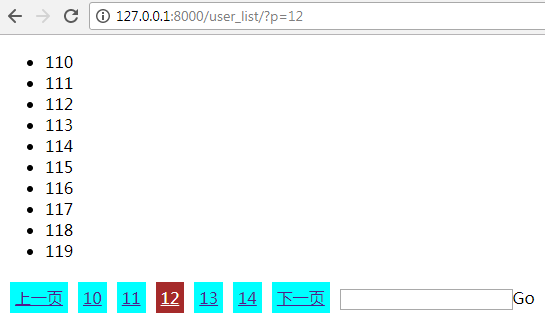
六。把分页的功能写到一个类里面,以后用这个类来做操作就可以了。
__init__(self,current_page,data_count,per_page_count=10,pager_num=7---------接收用户传来的参数并且封装值。
self.current_page=current_page---------开始封装功能
def start(self): 写2个方法
def end(self):写2个方法
per_page_count=10,pager_num=7
page_obj=Page(current_page,len(LIST)) : 实例化一个类
if self.total_count() < self.pager_num: 这里的total_count是一个类,调用的时候,应该加上括号。
当想访问类里面的方法,但是又不想加括号的话,可以在父类里面写上 @property
views.py
from django.shortcuts import render,HttpResponse
from django.urls import reverse
# Create your views here.
def tpl_1(request):
user_list=[1,2,3,4]
return render(request,'tpl_1.html',{'u':user_list})
def tpl_2(request):
name='root'
return render(request,'tpl_2.html',{'name':name})
def tpl_3(request):
status='已删除'
return render(request,'tpl_3.html',{'status':status})
def tpl_4(request):
name='AAABBBIYMFD12345'
return render(request,'tpl_4.html',{'name':name})
class Page:
def __init__(self,current_page,data_count,per_page_count=10,pager_num=7):
self.current_page=current_page
self.data_count=data_count
self.per_page_count=per_page_count
self.pager_num=pager_num
@property
def start(self):
return (self.current_page-1)*self.per_page_count
@property
def end(self):
return self.current_page*self.per_page_count
@property
def total_count(self):
v, y = divmod(self.data_count, self.per_page_count)
if y:
v = v + 1
return v
def page_str(self,base_url):
page_list = []
if self.total_count < self.pager_num:
start_index = 1
end_index = self.total_count + 1
else:
if self.current_page <= (self.pager_num + 1) / 2:
start_index = 1
end_index = self.pager_num + 1
else:
start_index = self.current_page - (self.pager_num - 1) / 2
end_index = self.current_page + (self.pager_num + 1) / 2
if (self.current_page + (self.pager_num - 1) / 2) > self.total_count:
end_index = self.total_count + 1
start_index = self.total_count - self.pager_num + 1
if self.current_page == 1:
prev = '<a class="page" href="javascript:void(0);">上一页</a>'
else:
prev = '<a class="page" href="%s?p=%s">上一页</a>' % (base_url,self.current_page - 1)
page_list.append(prev)
for i in range(int(start_index), int(end_index)):
if i == self.current_page:
temp = '<a class="page active" href="%s?p=%s">%s</a>' % (base_url,i, i)
else:
temp = '<a class="page" href="%s?p=%s">%s</a>' % (base_url,i, i)
page_list.append(temp)
if self.current_page == self.total_count:
nex = '<a class="page" href="javascript:void(0);">下一页</a>'
else:
nex = '<a class="page" href="%s?p=%s">下一页</a>' % (base_url,self.current_page + 1)
page_list.append(nex)
jump = """
<input type='text'/><a onclick='jumpTo(this,"%s?p=");'>Go</a>
<script>
function jumpTo(ths,base){
var val=ths.previousSibling.value;
location.href=base+val;
}
</script>
"""%(base_url,)
page_list.append(jump)
page_str = "".join(page_list)
page_str = mark_safe(page_str)
return page_str
from django.utils.safestring import mark_safe
LIST=[]
for i in range(200):
LIST.append(i)
def user_list(request):
current_page=request.GET.get('p')
current_page=int(current_page)
page_obj=Page(current_page,len(LIST))
data=LIST[page_obj.start:page_obj.end]
page_str=page_obj.page_str("/user_list/")
return render(request,'user_list.html',{'li':data,'page_str':page_str})
精简版本
views.py
from django.shortcuts import render,HttpResponse
from django.utils.safestring import mark_safe
# Create your views here.
class Page:
def __init__(self,current_page,data_count,per_page_count=10,pager_num=7):
self.current_page=current_page
self.data_count=data_count
self.per_page_count=per_page_count
self.pager_num=pager_num
@property
def start(self):
return (self.current_page - 1) * self.per_page_count
@property
def end(self):
return self.current_page*self.per_page_count
@property
def total_count(self):
v, y = divmod(self.data_count,self.per_page_count)
if y:
v = v+ 1
return v
def page_str(self):
page_list = []
if self.total_count < self.pager_num:
start_index = 1
end_index = self.total_count + 1
else:
if self.current_page <= (self.pager_num + 1) / 2:
start_index = 1
end_index = self.pager_num + 1
else:
start_index = self.current_page - (self.pager_num - 1) / 2
end_index = self.current_page + (self.pager_num + 1) / 2
if (self.current_page + (self.pager_num - 1) / 2) > self.total_count:
end_index = self.total_count + 1
start_index = self.total_count - self.pager_num + 1
if self.current_page == 1:
prev = '<a class="page" href="javascript:void(0)">上一页</a>'
else:
prev = '<a class="page" href="/user_list/?p=%s">上一页</a>' % (self.current_page - 1)
page_list.append(prev)
for i in range(int(start_index), int(end_index)):
if i == self.current_page:
temp = '<a class="page active" href="/user_list/?p=%s">%s</a>' % (i, i)
else:
temp = '<a class="page" href="/user_list/?p=%s">%s</a>' % (i, i)
page_list.append(temp)
if self.current_page == self.total_count:
nex = '<a class="page" href="javascript:void(0);">下一页</a>'
else:
nex = '<a class="page" href=/user_list/?p=%s>下一页</a>' % (self.current_page + 1)
page_list.append(nex)
jump = '''
<input type='text'/><a onclick='jumpTo(this,"/user_list/?p=");'>Go</a>
<script>
function jumpTo(ths,base){
var val=ths.previousSibling.value;
location.href=base+val;
}
</script>
'''
page_list.append(jump)
page_str = mark_safe("".join(page_list))
return page_str
LIST=[]
for i in range(200):
LIST.append(i)
def user_list(request):
current_page=request.GET.get('p')
current_page=int(current_page)
page_obj=Page(current_page,len(LIST))
data=LIST[page_obj.start:page_obj.end]
page_str=page_obj.page_str()
return render(request,'user_list.html',{'data':data,'page_str':page_str})
def page_str(self,base_url): 把url也当做参数写到函数里面,这样就可以根据需求变化了。
views.py
from django.shortcuts import render,HttpResponse
from django.utils.safestring import mark_safe
# Create your views here.
class Page:
def __init__(self,current_page,data_count,per_page_count=10,pager_num=7):
self.current_page=current_page
self.data_count=data_count
self.per_page_count=per_page_count
self.pager_num=pager_num
@property
def start(self):
return (self.current_page - 1) * self.per_page_count
@property
def end(self):
return self.current_page*self.per_page_count
@property
def total_count(self):
v, y = divmod(self.data_count,self.per_page_count)
if y:
v = v+ 1
return v
def page_str(self,base_url):
page_list = []
if self.total_count < self.pager_num:
start_index = 1
end_index = self.total_count + 1
else:
if self.current_page <= (self.pager_num + 1) / 2:
start_index = 1
end_index = self.pager_num + 1
else:
start_index = self.current_page - (self.pager_num - 1) / 2
end_index = self.current_page + (self.pager_num + 1) / 2
if (self.current_page + (self.pager_num - 1) / 2) > self.total_count:
end_index = self.total_count + 1
start_index = self.total_count - self.pager_num + 1
if self.current_page == 1:
prev = '<a class="page" href="javascript:void(0)">上一页</a>'
else:
prev = '<a class="page" href="%s?p=%s">上一页</a>' % (base_url,self.current_page - 1)
page_list.append(prev)
for i in range(int(start_index), int(end_index)):
if i == self.current_page:
temp = '<a class="page active" href="%s?p=%s">%s</a>' % (base_url,i, i)
else:
temp = '<a class="page" href="%s?p=%s">%s</a>' % (base_url,i, i)
page_list.append(temp)
if self.current_page == self.total_count:
nex = '<a class="page" href="javascript:void(0);">下一页</a>'
else:
nex = '<a class="page" href=%s?p=%s>下一页</a>' % (base_url,self.current_page + 1)
page_list.append(nex)
jump = '''
<input type='text'/><a onclick='jumpTo(this,"%s?p=");'>Go</a>
<script>
function jumpTo(ths,base){
var val=ths.previousSibling.value;
location.href=base+val;
}
</script>
'''%(base_url)
page_list.append(jump)
page_str = mark_safe("".join(page_list))
return page_str
LIST=[]
for i in range(200):
LIST.append(i)
def user_list(request):
current_page=request.GET.get('p')
current_page=int(current_page)
page_obj=Page(current_page,len(LIST))
data=LIST[page_obj.start:page_obj.end]
page_str=page_obj.page_str("/user_list/")
return render(request,'user_list.html',{'data':data,'page_str':page_str})
写在这里太长了,我们可以把它们挪到别处。新建utils文件夹----新建pagination.py文件
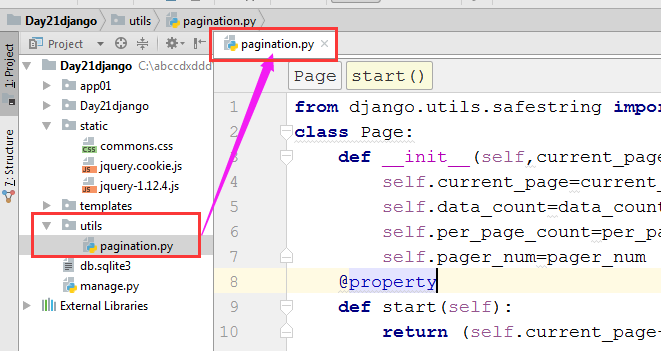
pagination.py
from django.utils.safestring import mark_safe
class Page:
def __init__(self,current_page,data_count,per_page_count=10,pager_num=7):
self.current_page=current_page
self.data_count=data_count
self.per_page_count=per_page_count
self.pager_num=pager_num
@property
def start(self):
return (self.current_page-1)*self.per_page_count
@property
def end(self):
return self.current_page*self.per_page_count
@property
def total_count(self):
v, y = divmod(self.data_count, self.per_page_count)
if y:
v = v + 1
return v
def page_str(self,base_url):
page_list = []
if self.total_count < self.pager_num:
start_index = 1
end_index = self.total_count + 1
else:
if self.current_page <= (self.pager_num + 1) / 2:
start_index = 1
end_index = self.pager_num + 1
else:
start_index = self.current_page - (self.pager_num - 1) / 2
end_index = self.current_page + (self.pager_num + 1) / 2
if (self.current_page + (self.pager_num - 1) / 2) > self.total_count:
end_index = self.total_count + 1
start_index = self.total_count - self.pager_num + 1
if self.current_page == 1:
prev = '<a class="page" href="javascript:void(0);">上一页</a>'
else:
prev = '<a class="page" href="%s?p=%s">上一页</a>' % (base_url,self.current_page - 1)
page_list.append(prev)
for i in range(int(start_index), int(end_index)):
if i == self.current_page:
temp = '<a class="page active" href="%s?p=%s">%s</a>' % (base_url,i, i)
else:
temp = '<a class="page" href="%s?p=%s">%s</a>' % (base_url,i, i)
page_list.append(temp)
if self.current_page == self.total_count:
nex = '<a class="page" href="javascript:void(0);">下一页</a>'
else:
nex = '<a class="page" href="%s?p=%s">下一页</a>' % (base_url,self.current_page + 1)
page_list.append(nex)
jump = """
<input type='text'/><a onclick='jumpTo(this,"%s?p=");'>Go</a>
<script>
function jumpTo(ths,base){
var val=ths.previousSibling.value;
location.href=base+val;
}
</script>
"""%(base_url,)
page_list.append(jump)
page_str = "".join(page_list)
page_str = mark_safe(page_str)
return page_str
views.py中的调用方法
from django.shortcuts import render,HttpResponse
from django.urls import reverse
# Create your views here.
def tpl_1(request):
user_list=[1,2,3,4]
return render(request,'tpl_1.html',{'u':user_list})
def tpl_2(request):
name='root'
return render(request,'tpl_2.html',{'name':name})
def tpl_3(request):
status='已删除'
return render(request,'tpl_3.html',{'status':status})
def tpl_4(request):
name='AAABBBIYMFD12345'
return render(request,'tpl_4.html',{'name':name})
from utils import pagination
LIST=[]
for i in range(200):
LIST.append(i)
def user_list(request):
current_page=request.GET.get('p')
current_page=int(current_page)
page_obj=pagination.Page(current_page,len(LIST))
data=LIST[page_obj.start:page_obj.end]
page_str=page_obj.page_str("/user_list/")
return render(request,'user_list.html',{'li':data,'page_str':page_str})
最终效果同上
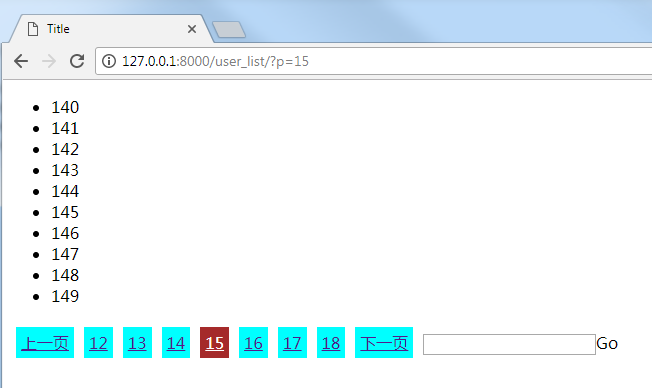
七,在浏览器中让用户自己选择每页显示的条数



